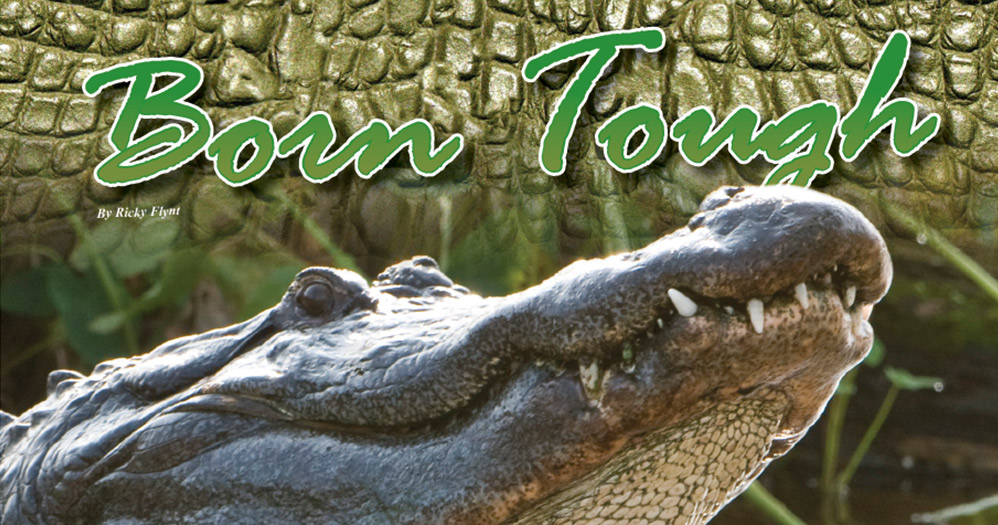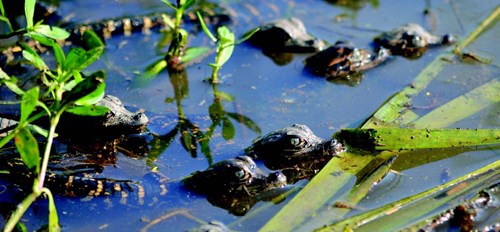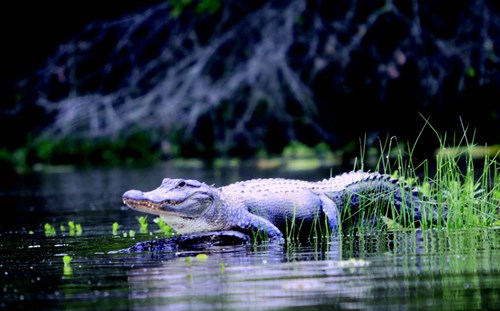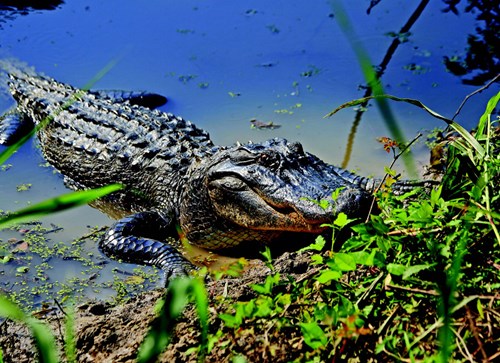Mississippi Outdoors: Alligators - Born Tough
8/17/2017 1:59:53 PM
By Ricky Flynt, Alligator Program Coodinator

Historical fossil records indicate that alligators, or a similar relative, have existed for millions of years. Therefore, alligators are regarded as living dinosaurs in North America.
Their biology is unlike any other wildlife found in North America. They are cold-blooded reptiles. They are long-lived animals that are immune to most diseases and have a natural ability to protect themselves from bacteria and infectious organisms frequently found in their aquatic environments.
Alligators are typically not sexually mature until they reach about 6 feet in length, which can take anywhere from 9 to 15 years. Once mature, growth rates are greatly reduced, especially for females. Females in excess of 9 feet are not that common and could easily be 40-50 years old (some known-age females have been in captivity for more than 35 years and barely exceeded eight feet in length).
As cold-blooded animals, the temperature is an important factor in their life cycle. They go through a distinct dormant period in the fall and winter. When water temperatures become cooler, the alligator’s body temperature becomes cooler resulting in less mobility and activity. Alligators stop feeding when water temperatures drop below 70 degrees because they can no longer digest food when their core body temperature reaches that level.
They still can be seen basking in the sunlight using the osteoderms (the network of bony plates on their back) as natural solar panels to retain heat and regulate their body temperatures during cooler days. Additionally, alligators have a unique ability to store oxygen in their blood and reduce respiration and heart rate. This allows the alligator to remain underwater for extended periods of time without needing to surface to breathe. If temperatures get cold enough, this allows them to shut down all body functions for days at a time.

They still can be seen basking in the sunlight using the osteoderms (the network of bony plates on their back) as natural solar panels to retain heat and regulate their body temperatures during cooler days. Additionally, alligators have a unique ability to store oxygen in their blood and reduce respiration and heart rate. This allows the alligator to remain underwater for extended periods of time without needing to surface to breathe. If temperatures get cold enough, this allows them to shut down all body functions for days at a time.
Temperature is also important as it relates to alligator reproduction. Alligators reproduce by laying eggs in the summer. Alligators do not sit on their eggs to incubate them. Unlike birds, the body of the alligator does not produce adequate heat to assist in incubation. Therefore, lying on the eggs like a bird does not work.
So, how does it work?
The adult female waits until the peak of summer to initiate building her nest. In Mississippi, alligators typically begin nesting activity around the first week of July. The female will find a secluded spot on dry ground close to the water (usually within 10-20 feet). The nest location is typically in an area of dense vegetation to provide as much concealment from predators as possible. The female will use her feet to scratch and gather live and dead vegetation, vines, woody debris, and soil, and heap it into a pile.
At completion, the nest heap is about 6-8 feet across at the base and about 2-2.5 feet high. She then excavates a hole in the center of the heap and deposits, on average, about 40 eggs, and then covers them up. The eggs will remain covered for 60-65 days as they incubate in the heap. During the “dog-days of summer,” the decomposing organic material within the nest creates heat just like a compost pile. The temperatures can reach the mid-90s in short order and this is how the eggs are incubated.

During a crucial period between 7 and 21 days of incubation, the sex of the young embryos is determined depending on the temperature of the eggs. During that critical period, eggs that are 91 degrees or warmer will become males. Eggs that are 86 degrees or less will become females. Eggs between 86-91 degrees can become a mix of males and females. There is usually temperature variation within the nest from top to bottom. Therefore, most nests will result in a mixture of sexes among the hatchlings, but potential exists for all hatchlings to be of the same sex in one nest. Once the hatchlings are fully developed, they will begin to vocalize with a high pitched barking/croaking sound. The adult female hears the hatchlings and will begin the process of excavating the hatchlings from the nest.
In 2014, with the assistance of Jim Tipton of Live Wildlife Video Systems in Madison, the Mississippi Department of Wildlife, Fisheries, and Parks (MDWFP) captured what is currently regarded as the most comprehensive video documentation of the hatching process of American alligators in the wild. The MDWFP has since obtained video documentation of three other successful hatching nests in Mississippi on the Pearl River north of Ross Barnett Reservoir. What was observed is an amazing maternal process. In all of the video observations, the females approach the nest (usually around midnight) and spend about 10- 15 minutes apparently listening and “homing-in” on the exact location of the vocalizing from the hatchlings within the nest. She then begins using her front feet to dig and her jaws to pull at the nest debris that has become packed during settling over the 60-65 days since the nest was built. After about 20 minutes of excavating, the first hatchling is uncovered, and the mother transports the hatchlings, one by one (sometimes multiple hatchlings), to the water.
The adult female’s mouth has a crushing strength of up to 3,000 pounds per square inch, yet it is sensitive enough to gently pick up fragile 1-day-old hatchlings without a scratch. Each trip from the nest to the water usually requires additional digging to uncover more eggs/hatchlings. The whole process results in 40-60 trips back and forth over about 12 hours. As nature has it, not all of the eggs will develop completely and some can be infertile. The video has shown evidence of the female occasionally consuming undeveloped or rotten eggs. It is believed that this is a way to allow the female to recover vital nutrients and avoid attraction of scavengers.
The MDWFP has recorded healthy alligators that were missing two legs, had gaping wounds in the chest cavity, or missing over half of their tail. Alligators have been recorded surviving without food for 12 months. Some have been captured with multiple wounds and lodged bullets in their bones and skin from years of cruel harassment and abuse. I regard alligators as the toughest and most resilient animals in North America, and even that might be an understatement.
Decades of conservation success have resulted in an abundant alligator population statewide, and has led to limited permitted alligator hunting opportunities in Mississippi since 2005. Each year approximately 6,000 Mississippians anxiously await the application process for 920 permits offered on public waterways, statewide. The 2017 Alligator Hunting Season on public waters will take place Aug. 25-Sept. 4.









